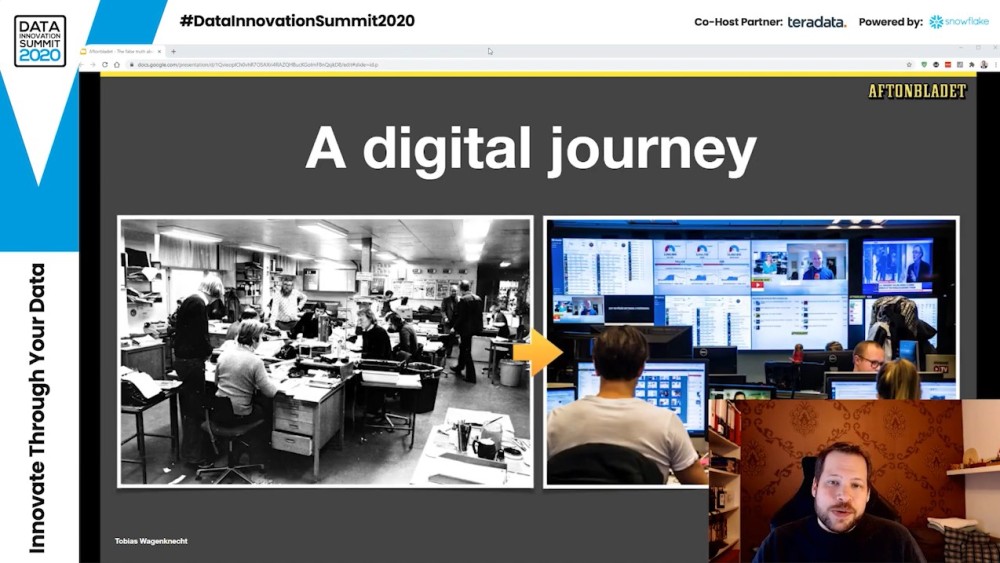To date, every company, no matter big or small, or the industry it operates in, knows that the only way forward is to become data-driven. Mining, analysing and deriving insights out of the fundamental asset is key for the business success in our digital world.
The subject of data-driven is one of the main discussions in boardroom meetings across the world, and yet few can offer the winning formula for how to truly become data-driven.
A real data-driven organisation makes all decisions based on data, which is readily available and openly shared, uses metrics to inspire and holds transparency above operations. Although this sounds perfectly simple, real-life cases have proved that switching to the data-driven world and abandoning gut-based decisions is easier said than done.
In the past several years, we’ve seen companies’ efforts to transform their culture towards a more data-oriented direction and tune their strategies to integrate data and analytics.
However, transformations proved more painstaking than expected. Even leading corporations failed in their efforts to become data-driven besides high investments in collecting and analysing data.


Adding to this are the results of last year’s survey among one of the largest companies from the ranks of American Express, Ford Motor, General Electric, General Motors, and Johnson & Johnson. Namely, less than a third from the participating companies described themselves as “data-driven”, while almost 70% report that they have not created a data-driven organisation, and more than half admit that they are not competing on data and analytics.
While all of us want to hear the success stories and fruits of becoming data-driven, we tend to overlook the struggles and failures that are part of the journey towards realising real returns on data investments.
McKinsey also recognises that the data revolution is changing businesses and industries in profound and unalterable ways. Nevertheless, these changes are not linear and uniform, as is evident in the gap between leaders and laggards when it comes to data and analytics implementation and utilisation. Some companies are breaking new grounds with data, while others are still stuck with the basics. No matter how mature and data-driven a company is, all experiences point to that data culture cannot be imported nor imposed, and most importantly, it cannot be segregated, describes McKinsey.
Real data-driven culture is company-wide, it goes beyond the analytics department and specialists. It should foster employee pull, engender a sense of purpose and boost a deep business engagement, so it results in business success.


The part that no one usually likes to talk about in becoming data-driven
Although no one can confidently say they have come to the finish line of the data culture race, some data leaders have made significant progress.
Looking at experts that have seen the best and the worst, have experienced failures, but have managed to gain significant momentum through the data-driven transformation, we have come across Tobias Wagenknecht, Head of Data & Analytics at Aftonbladet. During his Data Innovation Summit session at the Data Management Stage, Tobias openly talked about his personal experience and learnings, as well as shared some false truths about becoming data-driven.
As Tobias described, there is almost a hysteria among organisations to become data-driven across a variety of business areas and all at the same time. There is a general perception that everyone else is succeeding in data transformation, which portrays a false reality and breeds frustration.
In reality, and as we’ve seen previously, the majority of companies experience failures in their efforts to turn a more data-driven direction. And the truth is, failure is a natural segment of the process. In this case, Tobias shared a particular example where he was in charge of making a company data-driven and the reasons why the initiative failed.


Why did the data-driven initiative fail?
The first and foremost reason was that IT tried to run a business project, and as a person responsible for the data-driven project, he was located in IT. Secondly, nobody in the organisation knew what exactly “data-driven” meant.
Like so many cases before, technology and tools were a priority over business processes. Moreover, because they were relying on a legacy system, data quality was questionable. But data quality doesn’t automatically improve just by using newer technology. In this regard, we’d like to mention that the technology to assist in the journey is there and is important, but it shouldn’t overshadow the strategy and culture.
There cannot be data-driven without data. Tobias’s previous company which was in the hospitality industry didn’t have data in their company DNA. And the data they had was mainly manually generated by people for checking in guest and invoice updates.
Furthermore, Tobias admits that he didn’t focus on the fact that data-driven required change management above anything else to succeed. As one of the most common pitfalls, he tried to “boil the ocean” or do everything at the same time. He buried himself in creating fancy PowerPoints but neglected the communication with others.
The organisations also faced clashes between departments about which use case should be given priority. The team leading the initiative lacked clear sponsorship from senior management and the project was changed among several project owners within one year.


Why is it so difficult to become data-driven?
The above case is not unique. In fact, it is very much likely it happens and will happen to many other companies. Faced with this great challenge of becoming data-driven, we can’t help but ask “Why is it so difficult for companies to become data-driven?”.
Well, first of all, companies that want to become data-driven need to realise that they have to change their whole culture, which takes a lot of time, years, or even decades, explains Tobias.
To get a better idea, if we have to look back in history when other tectonic shifts were happening in the form of the Industrial Revolutions that forced changes in every industry and disrupted humanity. With every innovation, it took the society decades, or even a century to adapt and change. However, as technology advances rapidly, the rate of change also increases. So if it took 75 years for 1 million people to adopt the telephone, it took only two years for Instagram to catch on, and PokemonGo only one month to reach the same number of followers, Tobias says.
One thing is certain — customers are adapting faster to new technologies and their demands and expectations from products are also changing quickly. Large legacy corporations are having a much harder time coping with this accelerating change and keeping pace with their customers’ demands.


Why you may still feel like that everybody else is doing much better
Simply put, companies are only publicly showing what they want to be seen. They are not revealing their failures and struggles that are part of their data-driven journey, and which every organisation goes through naturally. As outsiders, we only see the fruits of their success, the aspects they made significant progress at. Their brilliant use cases and amazing success stories indeed inspire us, and at the same time make us doubt our efforts.
It certainly is great to hear others’ success stories to benchmark and help us with our data-driven efforts, but we have to take it with a grain of salt, Tobias advises because we are not looking at the whole truth, just a fraction of it.
But how can we proceed after learning the above? Tobias also shared a few words of advice.
Talk about failures too, not just successes
Tobias suggested that instead only sharing success stories, companies can also include their failures and struggles. This will help portray the whole picture and contribute to others feeling less like falling into the imposter syndrome trap.
“We are all struggling to adapt to this new revolution, and it will take a lot of time, patience and energy and many failures before we all eventually get there,” reveals Tobias.
There is no need to change everything overnight
Becoming data-driven can’t happen all at once in the whole organisation. That is impossible and unrealistic. Instead, start small with single use cases.
Surround yourself with like-minded people
Shifting the company into data-driven mode can’t be done alone. Tobias advises gathering people that share the same values, but who may have different opinions.
There is no magic tool for everything
Every use case should be solved at a time.
Data-driven is an ongoing process
Tobias strongly advises accepting the fact that you are probably never going to see the happy ending of an initiative that you have started.
Keep calm and accept your failures
When failures happen, and they will, we have to embrace them and share them with others.














Add comment